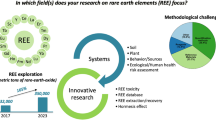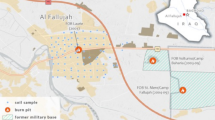Abstract
This research aimed to determine the background and precautionary values of Cd, Cr, Cu, Ni, Pb, Zn, Co, As, and Hg and provide the spatial distribution of these metals in Albania’s soils using statistical and geostatistical methods. Since the distribution of the data was commonly not Gaussian, they were transformed into their natural logarithm for deriving background concentrations and precautionary values. Background concentrations were defined as antilog of the median. Precautionary concentration values for soil protection were defined as antilog of 90th percentile of the ln-transformed data. Background concentrations in forest soils were larger compared to those in soils under other land use types. The largest background concentrations for Cd, Cr, Ni, Cu, Co, and Zn were found in forest soils formed on magmatic rocks, while largest concentrations of Pb and Hg were found in soils formed on flysch and molasse. The background values and precautionary concentration values (in brackets) (mg kg−1) for agricultural soils across flysch/molasses and quaternary deposits were as follows: Cd 0.24 (0.82), Cr 131.63 (527.42), Cu 41.26 (72.75), Ni 287.15 (632.70), Pb 19.11 (284.86), Zn 81.80 (113.90). The largest background values for Cd and Zn were found in Phaeozems, for Cr, Pb, and Co in Luvisols and Cambisols, and for Cu, Hg, and Ni in Fluvisols. The proposed background concentrations and precautionary values complete the picture of metal contents in European soils, can be used as reference concentrations for the Albanian environmental legislation, and allow the identification of potential contamination hot spots.







Similar content being viewed by others
Availability of data and material
The datasets used and/or analyzed during the current study are available from the corresponding author on reasonable request.
References
Abbaslou, H., Martin, F., Abtahi, A., & Moore, F. (2014). Trace element concentrations and background values in the arid soils of Hormozgan Province of southern Iran. Archives of Agronomy and Soil Science, 60, 1125–1143. https://doi.org/10.1080/03650340.2013.864387
Adriano, D. C. (2001). Trace elements in terrestrial environments: Biogeochemistry, bioavailability, and risks of metals (2nd ed.). Springer-Verlag.
Alikaj, M., & Brahushi, F. (2014). Assessment of heavy metals in soils around Viroi Lake in Gjirokastra district. Proceedings of the International Conference: On Green Energy and Environmental Science in Albania (pp. 221–225). 1–2 December 2014, Tirana, Albania.
Almeida Júnior, A. B., Nascimento, C. W. A., Biondi, C. M., Souza, A. P., & Barros, F. M. R. (2016). Background and Reference Values of Metals in Soil from Paraíba State, Brazil. Revista Brasileira de Ciência do Solo, 40, e0150122.
Alushllari, M., & Civici, N. (2015). Verification of penetration of lead in the profile of soil around the former battery production factory, Berat Albania. Journal of Environmental Protection, 6, 388–398. https://doi.org/10.4236/jep.2015.64038
Alloway, B. J. (1995). Heavy metals in soils (2nd ed., pp. 11–57, 122–205, 284–305, 356). London, U.K.: Blackie Academic & Professional.
Atanassov, I., & Terytze, K. (2002). Background values for heavy metals in the soils of Bulgaria. Proceedings of the 7th international meeting on soils with Mediterranean type of climate (pp. 55–57). 23–28 September 2001. Valenzano, Italy.
Atanassov, I. (2007). New Bulgarian Soil Pollution Standards. Bulgarian Journal of Agricultural Science, 14, 68–75. http://agrojournal.org/14/01-08-08.pdf. Accessed 7 September 2016.
Bani, A., Echevarria, G., Montargès-Pelletier, E., Gjoka, F., Sulçe, S., & Morel, J. L. (2014). Pedogenesis and nickel biogeochemistry in a typical Albanian ultramafic toposequence. Environmental Monitoring and Assessment, 186, 4431–4442. https://doi.org/10.1007/s10661-014-3709-6
Barałkiewicz, D., & Siepak, J. (1999). Chromium, Nickel and Cobalt in Environmental Samples and Existing Legal Norms. Polish Journal of Environmental Studies, 8, 201–208. http://www.pjoes.com/Chromium-Nickel-and-Cobalt-in-Environmental-Samples-and-Existing-Legal-Norms,87242,0,2.html. Accessed 22 January 2021.
Barbieri, M. (2016). The Importance of Enrichment Factor (EF) and Geoaccumulation Index (Igeo) to Evaluate the Soil Contamination. Journal of Geology and Geophysics, 5, 237. https://doi.org/10.4172/2381-8719.1000237
Bekteshi, A., & Bara, G. (2013). Uptake of Heavy Metals from Plantago major in the Region of Durrës, Albania. Polish Journal of Environmental Studies, 22, 1881–1885. https://www.researchgate.net/publication/286205428. Accessed 25 July 2016.
Belalla, S., Salillari I., Doko, A., Gjoka, F., & Cenameri, M. (2010). Content of heavy metals in Albanian soils and determination of spatial structures using GIS. In P. Zdruli, M. Pagliai, S. Kapur, A. Faz Cano (Eds.), Land Degradation and Desertification: Assessment, Mitigation and Remediation (pp. 389–400). https://in.b-ok2.org/book/2166499/f440bb. Accessed 4 February 2020.
Bodenschutz- und Altlastenverordnung (BBodSchV). (1999). Bundesanzeigerverlagsgesellschaft mbH. Köln, Bundesgesetzblatt, 12 July 1999.
Brus, D. J., Lame, F. P. J., & Nieuwenhuis, R. H. (2009). National baseline survey of soil quality in the Netherlands. Environmental Pollution (Barking, Essex: 1987), 157(7), 2043–2052. https://doi.org/10.1016/j.envpol.2009.02.028
Celo, V., Baraj, B., Babi, D., Cullaj, A., Kellezi, F., & Stalicas, C. (1996). A statistical assessment of heavy metals content in soils of some Albanian regions. Proceedings of the Scientific Symposium on Soil Resources in Albania (pp. 13–18). 7–9 November 1996, Tirana, Albania.
Chen, Z. S. (2000). Relationship between heavy metal concentrations in soils of Taiwan and uptake by crops. Technical Bulletin ASPAC/FFTC, 149, 17. https://www.cabdirect.org/cabdirect/abstract/20016787275. Accessed 22 January 2021.
Contin, M., Malev, O., Izosimova, A., & De Nobili, M. (2015). Flocculation of sewage sludge with FeCl3 modifies the bioavailability of potentially toxic elements when added to different soils. Ecological Engineering., 81, 278–288. https://doi.org/10.1016/j.ecoleng.2015.04.033
FAO. (2014). World Reference Base for Soil Resources 2014, updates 2015. International soil classification system for naming soils and creating legends for soil maps (p. 192). (World Soil Resources Reports No. 106). Food and Agriculture Organization of the United Nations (FAO), Rome, Italy. https://www.fao.org/3/i3794en/I3794en.pdf. Accessed 28 December 2021.
Gjoka, F., Felix-Henningsen, P., & Wagener, H.-R. (2002). Heavy metals in soils of vicinity of industrial Site of Laç, Albania. Balkan Ecology, 5, 301–306.
Gjoka, F., Felix-Henningsen, P., Wegener, H.-R., Salillari, I., & Beqiraj, A. (2011). Heavy metals in soils from Tirana (Albania). Environmental Monitoring and Assessment, 172, 517–527. https://doi.org/10.1007/s10661-010-1351-5
Gjoka, F., Salillari, I., Cenameri, M., & Llaveshi, P. (2007). Status of heavy metals of soils near the industrial complexes in Laç, Rubik and Burrel. Albanian Journal of Agricultural Science, 9, 35–41.
Hornburg, V., & Lüer, B. (1999). Vergleich zwischen Total- und königswasserextrahierbaren Elementgehalten in natürlichen Böden und Sedimenten. Journal of Plant Nutrition and Soil Science, 162(2), 131–137. https://doi.org/10.1002/(SICI)1522-2624(199903)162:2<131::AID-JPLN131>3.0.CO;2-1
Istituto Superiore di Sanità, Agenzia per la Protezione dell’Ambiente e per i Servizi Tecnici. (2006). Protocollo Operativo per la determinazione dei valori di fondo di metalli/metalloidi nei suoli dei siti d’interesse nazionale. http://www.iss.it/binary/suol/cont/PROT_VALORI_FONDO_06.pdf. Accessed 26 August 2016.
Kabata-Pendias, A. (2011). Trace elements in soils and plants (4th ed.). Taylor & Francis Group, Boca Raton London New York.
Kabata-Pendias, A., & Pendias, H. (2001). 2001 (2nd ed.). Trace Metals in Soils and Plants.
Kasa, E., Felix Henningsen, P., Duering, R.-A., & Gjoka, F. (2014). The occurrence of heavy metals in irrigated and non-irrigated arable soils. NW Albania. Environmental Monitoring and Assessment, 186, 3595–3603. https://doi.org/10.1007/s10661-014-3642-8
Kumar, A., & Maiti, S. K. (2013). Availability of chromium, nickel and other associated heavy metals of ultramafic and serpentine soil /rock and in plants. International Journal of Emerging Technologies and Advanced Engineering, 3, 256–268. www.ijetae.com. Accessed 25 August 2019.
LABO. (1995). Soil background and reference values in Germany (pp. 5–48). Federal Environmental Agency Report (Unpub. Report).
Mankolli, H., Peçuli, V., Tola, Y., & Spaholli, A. (2006). Contamination of soil and fodder plants with Pb and Cr in the Elbasan area. Albanian Journal of Agricultural Science, 7, 29–33.
McGrath, S. P., & Zhao, F. J. (2006). Ambient background metal concentrations for soils in England and Wales. Science Report: SC050054/SR SCHO1106BLPV. Environment Agency, Rio House, Waterside Drive, Aztec West, Almondsbury, Bristol, BS32 4UD. www.environment-agency.gov.uk. Accessed 26 August 2019.
Micó, C., Peris, M., Recatalá, L., & Sánchez, J. (2007). Baseline values for heavy metals in agricultural soils in an European Mediterranean region. Science of the Total Environment, 378, 13–17. https://doi.org/10.1016/j.scitotenv.2007.01.010
Oliveira, V. H., Abreu, C. A., Coelho, R. M., & Melo, L. C. A. (2014). Cadmium background concentrations to establish reference quality values for soils of São Paulo State, Brazil. Environmental Monitoring and Assessment, 186, 1399–1408.
Pavlíčková, J., Zbíral, J., Čižmárová, E., & Kubáň, V. (2003). Comparison of aqua regia and HNO3 + H2O2 procedures for extraction of twenty-one elements from soils. Analytical and Bioanalytical Chemistry, 376, 118–125. https://doi.org/10.1007/s00216-003-1845-x
Paz-Gonzalez, A., Taboada Castro, M. T., & Vieira, S. R. (2001). Geostatistical analysis of heavy metals in a one-hectare plot under natural vegetation in a serpentine area. Canadian Journal of Soil Science, 81, 469–479.
Rafique, N., & Tariq, S. R. (2016). Distribution and source apportionment studies of heavy metals in soil of cotton/wheat fields. Environmental Monitoring and Assessment, 188, 09. https://doi.org/10.1007/s10661-016-5309-0
Reimann, C., & Caritat, P. (2017). Establishing geochemical background variation and threshold values for 59 elements in Australian surface soil. Science of the Total Environment, 578, 633–648. https://doi.org/10.1016/j.scitotenv.2016.11.010
Sallaku, F., Fortuzi, Sh., Tota, O., Huqi, B., Chachalis, D., & Darawsheh, M. (2009). Heavy metal soil contamination around the metallurgical plant of Elbasani in Albania. Journal of Food Agriculture and Environment, 7, 878–881. www.world-food.net. Accessed 22 July 2016.
Santos-Frances, F., Martinez-Grana, A., Rojo, P. A., & Sanchez, A. G. (2017). Geochemical background and baseline values determination and spatial distribution of heavy metal pollution in soils of the Andes Mountain Range (Cajamarca-Huancavelica, Peru). International Journal of Environmental Research and Public Health, 14, 859–880. https://doi.org/10.3390/ijerph14080859
Saraçi, M., Çullaj, A., Robinson, D., & Damo, B. (1995). Analytical investigation of soil from a tree plantation in south-east of Albania. Fresenius Environmental Bulletin, 4, 624–629.
Shallari, S., Schwartz, C., Hasko, A., & Morel, J. L. (1998). Morel Heavy metals in soils and plants of serpentine and industrial sites of Albania. Science of the Total Environment, 209, 133–142. https://doi.org/10.1016/S0048-9697(98)80104-6
Shange, R. S., Ankumah, R. O., Githinji, L., & Zabawa, R. (2012). Spatial Assessment of Selected Soil Properties within an Industrial Poultry Production Site. Air, Soil and Water Research, 5, 59–68. https://doi.org/10.4137/ASWR.S9268, http://www.la-press.com
Shapiro, S. S., & Wilk, M. B. (1965). An analysis of variance test for normality (complete samples). Biometrika, 52(3/4), 591–611. https://doi.org/10.2307/2333709
Shtiza, A., Swennen, R., & Tashko, A. (2005). Chromium and nickel distribution in soils, active river, overbank sediments and dust around the Burrel chromium smelter (Albania). Journal of Geochemical Exploration, 87, 92–108. https://doi.org/10.1016/j.gexplo.2005.07.005
Spaho, S., Garo, R., Veshi, L., Vesho, T., & Zhako, P. (1986). Soil Science, 2, 347.
Tahri, M., Benyaïch, F., Bounakhla, M., Bilal, E., Gruffat, J. J., Moutte, J., & Garcia, D. (2005). Multivariate analysis of heavy metal contents in soils, sediments and water in the region of Meknes (central Morocco). Environmental Monitoring and Assessment, 102, 405–417. https://doi.org/10.1007/s10661-005-6572-7
Topi, T., Bani, A., Malltezi, J., & Sulce, S. (2012). Heavy metals in soil, sediments, mussels, and water from Butrinti Lagoon (Albania). Fresenius Environmental Bulletin, 21, 3042–3051. https://www.researchgate.net/publication/283345798
Acknowledgements
We thank Peter Felix-Henningsen and the technical staff of the Institute of Soil Science and Soil Conservation of the Justus Liebig University of Giessen (Germany) for many years of suppport.
Funding
Funding was provided by the Deutscher Akademischer Austauschdients (DAAD) (project number: 91573713).
Author information
Authors and Affiliations
Contributions
Fran Gjoka aquired funding, reviewed the literature, and collected the data. All authors interpreted the data. Fran Gjoka drafted the manuscript. Rolf-Alexander Düring and Jan Siemens provided cirtical revisions and amendments of the manuscript.
Corresponding author
Ethics declarations
Conflict of interest
The authors declare no competing interests.
Additional information
Publisher's Note
Springer Nature remains neutral with regard to jurisdictional claims in published maps and institutional affiliations.
Supplementary information
Below is the link to the electronic supplementary material.
Rights and permissions
About this article
Cite this article
Gjoka, F., Duering, RA. & Siemens, J. Background concentrations and spatial distribution of heavy metals in Albania’s soils. Environ Monit Assess 194, 115 (2022). https://doi.org/10.1007/s10661-022-09749-4
Received:
Accepted:
Published:
DOI: https://doi.org/10.1007/s10661-022-09749-4




